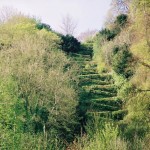The South Downs National Park has some of the most interesting Cultural Heritage in England. It includes everything from evidence of some of the earliest humans in Britain through to the most up to date artist work. It shows how people have lived, worked, shaped and been inspired by the landscape.
People’s activity has shaped the South Downs over the last 500,000 years, which is the most recent part of the story which started with the laying down of the chalk over 100 million years ago!
Key parts of the National Park’s cultural heritage include:
- archaeological sites of the Bronze and Iron Ages;
- villages, towns and important historic buildings, such as churches;
- early industrial sites from flint mines to ironworking furnaces;
- evidence of World War I and II;
- designed parks and gardens;
- artists, crafts people and scientists inspired by this landscape; and
- traditional fairs, customs and cultural events.
You can explore cultural heritage by visiting sites and museums to discover the secrets of our past and present.
Resources Toolbox
General Interest
All Ages
-

Cottage at Storrington, 1911 - Lucien Pissarro
Teachers notes. An impressionist painting of Waterfall Cottage in Storrington. View this artwork at Worthing Museum and Art Gallery. -

Eric Ravilious Cuckmere Haven
An image of Revilious’s painting of Cuckmere Haven with accompanying information. See this painting in the Towner Gallery. -

Eric Slater Coastguard Station Cuckmere Haven
An image of Eric Slater’s Coastguard Station Cuckmere Haven with accompanying information. -

Findon Fair, c.1934 - C.W. Taylor
Teachers notes. A wood engraving capturing the scene of the Findon Fair in monochrome. View this artwork at Worthing Museum and Art Gallery. -

Mill Near Midhurst, 1961 - Bruce Barnden
Teachers notes. An oil painting depicting Terwick Mill near Rogate which was a working water mill. View this artwork at Worthing Museum and Art Gallery. -

South Downs National Park Interactive Map
This interactive pdf allows you to display a variety of map layers: transport, rivers & coast, settlements, landscape types, contours, historical features, population and geology. Download and open in Adobe Reader to turn layers on and off. -

South Downs National Park Interactive Map - legend
This is the legend for the interactive pdf that allows you to display a variety of map layers. -

Sussex Smocks, early 20th century
Teachers notes. A resource looking at the design of Sussex smocks as part of the Our Place art exhibition. View these smocks at Worthing Museum and Art Gallery. -

The Fish, The Goatsucker and The Highwayman
Also available to buy at the South Downs Centre, this book tells stories of our heathlands, researched and written by our volunteers -

The Miller’s Tomb, c1820 - James Rouse
Teachers notes. A hand coloured lithograph of the Miller’s Tomb on top of Highdown hill near Worthing. View this artwork at Worthing Museum and Art Gallery. -

Worthing print, c1860 – artist unknown
Teachers notes. A lithograph showing a view of Worthing with the South Downs in the background. View this artwork at Worthing Museum and Art Gallery.
Key Stage 1
Ages 5–7
Years 1 and 2
-

Learning Outside the Classroom in Moulescoomb
A case study showing how Moulescoomb Primary links their school grounds to the heritage and culture of their local area. -

The Fish, The Goatsucker and The Highwayman
Also available to buy at the South Downs Centre, this book tells stories of our heathlands, researched and written by our volunteers
Key Stage 2
Ages 7–11
Years 3, 4, 5 and 6
-

Learning Outside the Classroom in Moulescoomb
A case study showing how Moulescoomb Primary links their school grounds to the heritage and culture of their local area. -

The Fish, The Goatsucker and The Highwayman
Also available to buy at the South Downs Centre, this book tells stories of our heathlands, researched and written by our volunteers






